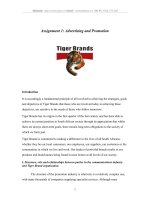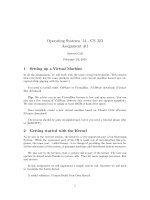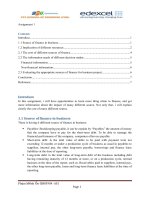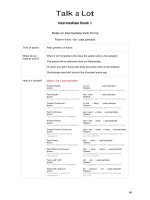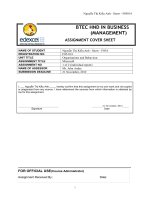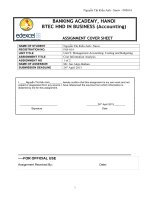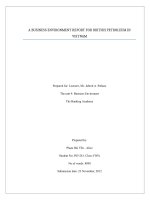1690 assignment 1 (pass)
Bạn đang xem bản rút gọn của tài liệu. Xem và tải ngay bản đầy đủ của tài liệu tại đây (1.37 MB, 29 trang )
Assignment Brief 1 (RQF)
Higher National Certificate/Diploma in Business
Student Name/ID Number:
Đào Vĩnh Khang/ GCS200222
Unit Number and Title:
Unit 43 – Internet of Things
Academic Year:
2022
Unit Assessor:
Ho Hai Van
Assignment Title:
Assignment 1 – Internet of Things
Issue Date:
Submission Date:
Internal Verifier Name:
Date:
Submission Format:
Format:
This assignment is an Individual assignment and specifically including 1 document:
You must use font Calibri size 12, set number of the pages and use multiple line spacing at
1.3. Margins must be: left: 1.25 cm; right: 1 cm; top: 1 cm and bottom: 1 cm. The reference
follows Harvard referencing system. The recommended word limit is 2.000-2.500 words.
You will not be penalized for exceeding the total word limit. The cover page of the report
has to be the Assignment front sheet 1.
Submission Students are compulsory to submit the assignment in due date and in a way requested by
the Tutors. The form of submission will be a soft copy posted on
/>Note:
The Assignment must be your own work, and not copied by or from another student or from
books etc. If you use ideas, quotes or data (such as diagrams) from books, journals or other sources, you
must reference your sources, using the Harvard style. Make sure that you know how to reference
properly, and that understand the guidelines on plagiarism. If you do not, you definitely get fail
Unit Learning Outcomes:
LO1 Analyse what aspects of IoT are necessary and appropriate when designing software applications
LO2 Outline a plan for an appropriate IoT application using common architecture, frameworks, tools, hardware
and APIs
LO3 Develop an IoT application using any combination of hardware, software, data, platforms and services.
Page 1
LO4 Evaluate your IoT application and detail the problem your IoT application solves, the potential impact on
people, business, society and the end user and the problems it might encounter when integrating into the wider
IoT ecosystem
Assignment Brief and Guidance:
You currently work as a product developer for a new startup where you design IoT products for the
consumer, corporate, government and defence clients. As part of your role your manager has tasked you
to plan and develop a new IoT product, service or application for a potential client. You are required to
identify a target user and conduct tests with this user and include this feedback into multiple iterative
versions of your product.
Part 1 (Assignment 1): For the first part, you must:
•
•
Plan an IoT application for a specific target end user and the tests you intend to conduct with this
user. This plan will be in the form of a document and will include supporting evidence and
material, such as user personas and customer journey maps.
Create multiple iterations of your application and modify each iteration with enhancements
gathered from user feedback and experimentation. This will follow the pathway outlined in your
plan.(log book,)
Part 2 (Assignment 2): For the first part, you must:
•
•
Show evidence about Developed IoT application using any combination of hardware, software,
data, platforms and services (video or images of your IoT system with code snippet)
Evaluate your IoT application and detail the problem your IoT application solves, the potential
impact on people, business, society and the end user and the problems it might encounter when
integrating into the wider IoT ecosystem
Page 2
Learning Outcomes and Assessment Criteria
Pass
Merit
Distinction
LO1 Analyse what aspects of IoT are necessary and appropriate when designing software
applications
P1 Explore various forms of
IoT functionality.
P2 Review standard
architecture, frameworks,
tools, hardware and APIs
available for use in IoT
development.
M1 Evaluate the impact of
common IoT architecture,
frameworks, tools, hardware and
APIs in the software development
lifecycle.
D1 Evaluate specific forms of
IoT architecture and justify their
usage when designing software
applications.
M2 Evaluate the impact of
common IoT architecture,
frameworks, tools, hardware and
APIs in IoT security.
LO2 Outline a plan for an appropriate IoT application using common architecture, frameworks,
tools, hardware and APIs
P3 Investigate architecture,
frameworks, tools, hardware
and API techniques available
to develop IoT applications.
P4 Determine a specific
problem to solve using IoT.
M3 Select the most appropriate
IoT architecture, frameworks,
tools, hardware and API
techniques to include in an
application to solve this problem.
D2 Make multiple iterations plan
of your IoT application and
modify each iteration to improve
your IoT application security.
M4 Apply your selected
techniques to create an IoT
application development plan.
Page 3
Table of contents
Assignment Brief 1 (RQF) ................................................................................................................................2
Higher National Certificate/Diploma in Business ............................................................................................2
Table of Contents ............................................................................................................................................1
Assignment 1 Report .......................................................................................................................................2
Task 1 – Review and evaluate about IoT aspects. ...........................................................................................2
1.
Explore various forms of IoT functionality. (P1) ...................................................................................2
2.
Review standard architecture, frameworks, tools, hardware, and APIs available for use in IoT
development. (P2) ...........................................................................................................................................7
3. Investigate architecture, frameworks, tools, hardware, and API techniques available to develop IoT
applications. (P3) ............................................................................................................................................8
4. Determine a specific problem to solve using IoT. (P4)...............................................................................20
REFERENCES ...................................................................................................................................................22
Page 4
Assignments
P1/ Explore various forms of IoT functionality.
1/ Definition of IOT.
The internet of things, or IoT, is a network of connected computing devices, mechanical and digital
machinery, items, animals, or people that are provided with unique identifiers (UIDs) that may exchange
data across a network without requiring human-to-human or human-to-computer interaction. These
gadgets include anything from common domestic items to high-tech industrial gear. Today, there are more
than 7 billion connected IoT devices, and according to analysts, there will be 10 billion by 2020 and 22
billion by 2025.
The term "thing" refers to any natural or artificial object that can be given an Internet Protocol (IP) address
and could transfer data over a network, including people with implanted heart monitors, farm animals with
biochip transponders, cars with built-in tire pressure monitors, and other examples.
Organizations across a range of industries are increasingly utilizing IoT to run more smoothly, better
understand their consumers to provide better customer service, boost decision-making, and raise the value
of the company.
2/ How does IoT work?
The Internet of Things (IoT) ecosystem is made up of web-enabled smart devices that use embedded
systems, such as processors, sensors, and communication gear, to gather, send, and act on the data they
get from their surroundings. By connecting to an IoT gateway or other edge device, which either sends data
to the cloud for analysis or analyzes it locally, IoT devices exchange the sensor data they collect. These
gadgets converse with other similar devices on occasion, acting on the data they exchange. Although
individuals can engage with the devices to set them up, give them instructions, or retrieve the data, the
gadgets accomplish much of the job without their help.
These web-enabled devices' connectivity, networking, and communication protocols are heavily influenced
by the IoT applications that have been implemented.
IoT can also employ machine learning and artificial intelligence (AI) to help make data collection processes
simpler and more dynamic.
Page 5
3/ Applications of IoT.
Business-ready, SaaS IoT Applications
IoT Intelligent Applications are prebuilt SaaS applications that can analyze and display IoT sensor data to
corporate users via dashboards. A whole range of IoT Intelligent Applications are available.
IoT apps analyze vast volumes of linked sensor data in the cloud using machine learning algorithms. You
may see important performance indicators, statistics for the mean time between failures, and other data
using real-time IoT dashboards and alerts. Algorithms built on machine learning can detect abnormalities in
equipment, inform users, and even start automated repairs or preventative steps.
Business users may immediately improve current operations for supply chains, customer service, human
resources, and financial services with cloud based IoT apps. There is no need to start from scratch with
every business procedure.
Page 6
4/ IoT characteristics.
There are the following characteristics of IoT as follows. Let’s discuss it one by one.
•
Connectivity
Connectivity is an important requirement of the IoT infrastructure. The IoT infrastructure should be
connected to IoT objects. This should always be guaranteed to be possible for everyone, everywhere, at
any time. For instance, connections between individuals via internet-connected devices like
smartphones and other gadgets, as well as connections between individual Internet-connected objects
like routers, gateways, sensors, etc.
•
Intelligence and Identity
It is crucial to extract knowledge from the generated data. For instance, a sensor might produce data,
but that information won't be helpful unless it is properly evaluated. IoT devices each have a distinct
identity. The equipment can sometimes be tracked using this identity, and its condition can occasionally
be inquired.
•
Scalability
The number of elements connected to the IoT zone is increasing day by day. An IoT setup should
therefore be able to handle the enormous expansion. Because of how much data is produced as a
result, it needs to be handled carefully.
•
Dynamic and Self-Adapting (Complexity)
IoT devices should dynamically adjust to the various scenarios and contexts. Assume there is a camera for
surveillance. It should be flexible enough to operate in various lighting and environmental circumstances
(morning, afternoon, night).
•
Architecture
IoT architecture can't be uniform in design. It must be hybrid and able to work with items from various
manufacturers in the IoT network. No engineering branch owns the Internet of Things. When several
disciplines join, IoT becomes a reality.
•
Safety
When a user's gadgets are all online, there is a risk that the user's sensitive personal information will be
compromised. The user may suffer a loss as a result. Data security is the main issue as a result. In
addition, the necessary equipment is enormous. IoT networks could also be under danger. Safety of the
equipment is therefore essential.
Some examples for real world application of IoT.
Page 7
•
Shopping Mall – Proximity Marketing
The modern consumer loves the ease of a digital lens but also likes to feel and touch products before
making a purchase. As a result, when a customer who frequently visits a store is in close proximity to
that store, IoT sensors can send the customer's information to the hyper decision framework, which will
analyze the customer's behavior and shopping patterns to send the appropriate message to the
appropriate person, at the appropriate time and place.
•
Asset Tracking
High-value inventory, tools, fixtures, dies, jigs and other items for the industry are examples of assets.
For the healthcare industry, examples of assets include numerous movable test machines like the ECG
machine, portable X-ray machines, portable ultrasound machines, stretchers, and wheelchairs. These
assets must be tracked in order to make it simple to keep track of their location, and lifespan, and help
with yearly asset audits.
BLE IoT sensors are used to connect assets. Anyone who requires information about the asset can check
the dashboard, application, or mobile device to see where it is because these sensors communicate
with the receivers.
•
Warehouse Pallet Tracking
For many businesses, reusable pallets in a warehouse are a valuable resource. Pallet tracking makes it
simple to identify the location of the pallets and helps to prevent time and valuable inventory waste as
warehouses grow in size and the variety of inventory expands every year.
Pallets may also be equipped with BLE IoT sensors, which can offer useful details on the pallet's position
as well as the inventory and date it is holding.
•
Employee Monitoring
Monitoring employees on the organization's campus are crucial for security and morale-boosting
reasons in addition to productivity-boosting purposes.
Employees can wear BLE IoT sensors in the form of ID cards. These ID cards feature Internet of Things
(IoT) sensors that can detect whether the card is on a person or not, allowing security to be handled
and productivity to be tracked based on proximity to each machine or process.
•
Temperature and Humidity Monitoring
The application of IoT sensors in supply chain management for "Cold Chain" is greatest. These sensors
take temperature and humidity readings within the containers and relay the information along with the
truck's GPS location. The advantage over existing data recorders is that the IoT sensor can communicate
with the Hyper Decision Framework and assist in real-time problem correction rather than
fingerpointing and playing the blame game. saving time, money, and reputation in the process.
•
Security Patrol Guard Management
Page 8
When a terrorist attack occurs, security guards' primary problem is that they lack the means to contact
their teammates and ask for assistance. The security patrol guard must frequently choose between
losing his weapon and his life.
How does the Internet of Things help in this situation? The BLE ID Card is carried by the security guard
over his shoulder. He can double-click the distress button on the card in the event of an attack. The
hyper decision framework engages to send the message to the closest available support when this SoS
signal is sent in real-time to the IoT cloud server.
P2. Review standard architecture, frameworks, tools, hardware and APIs available for use
in IoT development.
1/ IOT architecture.
IoT architecture, in its simplest form, is a collection of components including sensors, protocols,
actuators, cloud services, and layers. IoT architecture has four stages due of its complexity. This
quantity is designed to gradually integrate these many types of components into an advanced and
cohesive network.
Advantages:
•
•
•
•
•
•
Make edge devices simpler and less expensive.
A gateway can serve as a hub for connecting wireless and various data standards.
Protocols that present a consistent exterior to the outer world.
Rather than having to interact with each component individually, things are simple to monitor and
regulate as a whole.
Gateway can manage what information is transferred to the Internet and offer greater security than
items.
Easy to integrate legacy equipment with the IoT.
Disadvantages
•
•
•
An additional "Tier" increases integration complexity
Resources are still locally stored as opposed to accessing the cloud
An additional point of failure
2/ IOT NETWORK SYSTEM ARCHITECTURE
Page 9
As you can see from the image above, the IoT architecture has 4 layers: the sensor layer, the network
layer, the data processing layer, and the application layer.
Sensor Layer
Sensors, actuators, devices are included in this sensor class. These sensors or actuators receive data
(Physical/Environmental parameters), process the data, and transmit it over the network.
Network Layer
Internet (network) gateways, data acquisition systems (DAS) appear in this layer. The DAS performs the
function of data aggregation and conversion (Collects data and aggregates data and then converts the
sensor's analog data to digital data, ...) Advanced ports mainly open the connection between Sensor
networks and the Internet also perform many basic functions, such as anti-malware protection and
filtering some decision-making based on entered data and data management services.
Data Processing Layer
This is the processing unit of the IoT ecosystem. Here, data is analyzed and processed before being sent
to the data center, where the data is accessed by software applications commonly known as business
applications. This is where data is tracked and managed. Other actions are also prepared in this class.
Page 10
Application Layer
This is the final layer of the 4 phases of the IoT architecture. Data center or cloud (Cloud) is the
management stage where data is managed and used by end user applications such as agriculture,
healthcare, aerospace, agriculture, international rooms and other applications.
P3 Investigate architecture, frameworks, tools, hardware, and API techniques available to
develop IoT applications.
1/ IOT architecture.
IoT architecture is made up of the hardware, networks, and cloud technologies that enable interoperability
between IoT devices. A fundamental IoT architecture has three layers:
•
•
•
Perception (the sensors, gadgets, and other devices)
Network (the connectivity between devices)
Application (the layer the user interacts with)
These layers provide IoT device support by gathering and processing data. This architecture goes beyond
the OSI model by incorporating the conversion of data into information that may be used. Using
automation, machine learning, and artificial intelligence, these insights enable organizations to take quick
action.
Not only that but either three or five levels can be used to describe IoT architecture. Although the threelayer model is widely acknowledged to be straightforward to comprehend, it omits certain crucial
information about how the data is used. The functions of each layer, as well as their significance, are
broken down below.
Perception
The physical IoT devices themselves are represented by the perception layer. This can include things like
security systems, robotics, autonomous cars, lighting systems, and health monitoring. Every IoT device
gathers data that needs to be processed.
IoT sensors can gather hundreds of different data points for processing and are reasonably priced. The
information gathered will differ based on the organization's objectives. For instance, to increase crop yield
and revenue, agricultural IoT devices can record atmospheric data, moisture levels, solid temperature, and
airflow.
Transport
The transport layer oversees transmitting gathered data to an edge device or the cloud for processing. Data
is transferred from the physical perception layer into the processing stage by the transport layer using
internet gateways.
The transport layer is frequently used by administrators to transmit data between cellular and Wi-Fi
networks. System administrators can make use of the following technologies at this stage: + Cellular 4G LTE
/ 5G
Page 11
+ Wi-Fi
+ Bluetooth
+ Low-Power Wide-Area Networks
Administrators can mix and match different transport protocols to create their own IoT architecture. The
transport protocol you choose ultimately needs to be able to support data reliably from the sensor to the
nearest internet gateway. In our post on IoT connectivity, we go into greater detail about this idea.
Processing
Data can be converted into information by the server once it has reached the cloud or edge device.
Modern IoT systems make use of artificial intelligence and machine learning, which provide value by
evaluating this data.
For example, artificial intelligence may detect anomalies, such as a high-temperature variation being
recorded by an IoT sensor, by comparing the current temperature to its baseline. In this situation, the
server could be able to instruct an HVAC system to reduce the temperature and fix the problem.
Application
Although processing is normally done without human involvement when specific criteria are met or
thresholds are crossed, people still need to instruct the server on what to do. Administrators control IoT
device orchestration, develop rule sets, and establish service-level agreements for their IoT architecture at
the application layer.
You've utilized the application layer if you've ever used an app to switch on the lights in your house.
Reliable IoT designs monitor and operate their networks from a centralized dashboard by using the
application layer. Especially in enterprise IoT networks, this centralization minimizes complexity, enhancing
productivity and security.
Business
Finally, we arrive at the business layer, where information is converted into business intelligence that
guides decision-making, is the last layer we reach. The insights gathered at the application layer can be
used by executives and stakeholders to improve business choices.
For business intelligence, the business layer often uses reports and real-time dashboards. Through
additional integrations, data gathered from the application layer can be further enhanced. For instance, by
comparing electricity consumption before and after the installation of smart lighting sensors, business
intelligence analysts can determine cost savings.
2/ IOT frameworks.
IoT is a crucial component of a sizable IoT ecosystem, which supports and connects all components of the
system. It enables device administration, manages software and hardware connection protocols, gathers
and analyzes information, enhances information flow, and enhances the operation of intelligent apps.
Page 12
Typically, there needs to be a specific location where everything is gathered and integrated when vast
amounts of data are being generated and communicated across several devices.
In a network, this particular point is crucial since it aggregates all the data and enables comprehension of
the newly generated data.
Definition.
The Internet of Things (IoT) Framework can be thought of as an ecosystem made up of numerous linked
devices that interact with one another online. These Internet-connected devices often function to send and
sense data while requiring very little human involvement.
The Internet of Things (IoT) framework enables seamless communication between linked devices.
Therefore, it should come as no surprise that it is known as the "Internet of Things" framework, or, to put it
another way, the framework that makes it possible for objects to communicate with one another over the
Internet.
With applications in practically every industry, the Internet of Things framework is a crucial component of
technology in the present world. For instance, the design of smart houses is one of the IoT's key
applications.
The IoT framework concept is used for developing a variety of physical objects, including vending machines,
electrical equipment, security and alarm systems, and thermostats, among many other objects.
Main Components of IOT Framework.
Page 13
The IoT Framework is made up of four main parts, which are covered below:
Device Hardware
The IoT framework's device hardware requires a fundamental understanding of architecture. Additionally,
the user must be familiar with how the various micro-controllers and sensors operate.
Sensors, micro-controllers, and controllers are a few examples of hardware devices that make up this IoT
framework component.
Device Software
The supplied writing programs must configure the controller and then be used remotely in order for the
device software of the IoT framework to perform as intended. The user must have a fundamental
understanding of how libraries are typically created for programming, as well as how an API functions
inside microcontrollers.
Communication and Cloud Platform
One of the most important components of the IoT architecture is the cloud platform. It requires a
fundamental understanding of all forms of communication, both wired and wireless. Additionally, the user
must be well-versed in both the operation of cloud technology and IoT integration.
In conclusion, we can say that the IoT Framework's communication and cloud platform is where all
conversations take place.
Cloud Application
A sort of software program called a cloud application primarily comprises of elements that can be accessed
more quickly and easily. These components may be local or even hosted in the cloud. The system is
improved by the cloud application so that its full potential can be fulfilled.
Page 14
To put it another way, a cloud application is the written implementation of an IoT framework that connects
all of the local hardware devices and cloud-based gadgets.
3/ List of IoT Framework.
Now we will discuss the IoT Framework one by one
KAA IoT
One of the best and most complete Open-Source Internet of Things Cloud Platforms is Kaa IoT, where
anyone is free to freely apply their smart product concepts. On this platform, N number of devices that are
interconnected and can communicate with each other is manageable. By setting up remote devices, you
may provide real-time machine monitoring. The IoT Cloud, information and visualization systems, as well as
other components of IoT Ecosystems, are all made possible by Kaa.
Cisco IoT Cloud Connect
Cisco IoT Cloud Connect offers the company reliable, automated, and highly secure communication. The
Cisco Kinetic IoT platform handles IoT data management in order to extract, transport, and compute the
data. As Cisco is well known for its security services, it uses a secure IoT architecture to defend IoT
deployment against attacks.
ZETTA IoT
Zetta is nothing more than a server-oriented platform created using the Siren hypermedia-API-strip flowbased reactive programming methodology, NodeJS, and REST. They are linked to cloud services after being
abstracted as REST APIs. These online services include Splunk and other tools for displaying machine
statistics and assistance. Through connecting with platforms like Heroku to endpoints like Arduino and
Linux hackers, it creates a geo-distributed network.
Salesforce IoT
The thunder that powers Salesforce. With Thunder, businesses can access previously undiscovered ideas
and everyone can engage in proactive, personalized actions from any device to become closer to their
customers than before. Salesforce maintained more than 150,000 clients across the globe. In the world of
CRM, Salesforce holds a 19.7 percent market share. Oracle (9.1 percent), SAP (12.1%), and Microsoft (6.2%)
lag well behind their closest competitors. Today, many companies use the Salesforce platform to create
their apps or switch to Salesforce. Because of this, Salesforce is in more need of developers and
administrators.
Device Hive IoT
Another robust IoT open-source platform is Device Hive, which is freely usable and modifiable and given
under the Apache 2.0 license. It may be downloaded and utilized by both public and private clouds and
offers deployment options for Kubernetes and Docker. Beyond the knowledge of your device, batch
analysis and machine learning are possible. Numerous libraries, including Android and iOS, are supported
by Device Hive.
Page 15
4/ IOT tools
The term "IoT Tools" refers to the Internet of Things Tools. It is a collection of gadgets, cars, machinery with
embedded electronics, home appliances, structures, and more. This facilitates the gathering and exchange
of many types of data. The ability to remotely control the devices across a network is another benefit.
IoT is the newest buzzword in today's internet-driven society and has taken over the IT sector. For
businesses and IoT developers, it has extended numerous new vistas. The creation of IoT apps has led to
the creation of several amazing items. Internet of Things solution providers are developing hardware and
software designs to assist IoT developers in developing innovative IoT devices and apps.
Some IoT tools and devices are discussed below:
Tessel 2
It is used to build basic IoT prototypes and applications. It helps through its numerous modules and
sensors. Using Tessel 2 board, a developer can avail Ethernet connectivity, Wi-Fi connectivity, two USB
ports, a micro-USB port, 32MB of Flash, 64MB of RAM. Additional modules can also be integrated like
cameras, accelerometers, RFID, GPS, etc.
Tessel 2 can support Node.JS and can use the libraries of Node.JS. It contains two processors, its hardware
uses 48MHz Atmel SAMD21 and 580.
MHz MediaTek MT7620n coprocessor. One processor can help to run firmware applications at high speed
and the other one helps in the efficient management of power and in exercising good input/output control.
Eclipse IoT
The user can create, adopt, and promote open source IoT technologies using this tool or instrument.
Building IoT gadgets, Cloud platforms, and gateways is where it excels. Eclipse supports a number of IoTrelated initiatives. These initiatives consist of open-source implementations of IoT protocols, frameworks
Page 16
and services for applications, and tools for the Lua programming language, which is marketed as the best
one for IoT.
Arduino
Arduino is an Italy based IT company that builds interactive objects and microcontroller boards. It is an
open-source platform for prototyping that provides both IoT software and hardware. Interactive
electronics can use hardware requirements, and software options include the Integrated Development
Environment (IDE). Out of all the IoT development tools, it is the preferred IDE. It's straightforward and
easy to utilize this platform.
Platform IoT
It is a universal IoT IDE. The embedded debugger is included. It is the finest for creating mobile apps, and
developers can work in a welcoming IoT environment. The IDE can be installed as a plugin or as a port on
the Atom editor by a developer. It has more than 20 programming frameworks and platforms and is
compatible with more than 400 embedded boards. It is simple to use and has an amazing interface.
M2M Labs Mainspring
It is both an open-source application framework and an IoT platform. It is used to create machinetomachine (M2M) systems, which can be applied to fleet management and remote monitoring. Numerous
features are supported, including configurable device modeling, data validation and normalization, device
configuration, and data retrieval procedures. It is built on top of Apache, Cassandra, Java, and NoSQL
databases.
Kinoma
It is a hardware prototyping platform for Marvell semiconductors. It makes three various initiatives
possible. There are two products available to help these projects. Create an Element Board by Kinoma. A
hardware kit called Kinoma Create is used to prototype electronic and IoT-enabled gadgets. The kit includes
necessary auxiliary components like Bluetooth Low Energy (BLE), built-in Wi-Fi, a speaker, a microphone,
and a touch screen. The smallest IoT product platform driven by JavaScript is called Element Board.
Device- Hive
It is based on AllJoyn by Data Art. It is a machine-to-machine (M2M) communication framework that is free
and open source. It was introduced in 2012 and is regarded as the best platform for creating IoT
applications. It has a cloud-based API that is remotely controllable regardless of network settings. Similar
controls apply to its libraries, protocols, and management portal. Applications including smart home
technology, security, automation, and sensors are ideally suited for it.
Kaax
It offers complete support for IoT devices linked to the cloud. It enables customers to create linked
applications, IoT applications, and other smart goods thanks to its multi-purpose middleware. According to
Kaax, open-source kit is "hardware agnostic," meaning it may connect to any hardware, including sensors,
Page 17
gateways, and other devices. It enables cross-platform interoperability and aids in the remote firmware
update distribution process for developers.
Home Assistant
It is an open-source application mostly used for home automation and Python-based tasks. Browsers on
desktop computers and mobile devices support IoT system control. It is well known for its smooth
operations, privacy protections, and security and is simple to set up. It is compatible with Python 3
systems.
Net
For IoT developers, it provides a comprehensive solution. It provides solutions like corporate intelligence
and cloud integration.
Raspbian
For the Raspberry Pi board, this IDE was developed. It supports more than 35000 packages and enables
quick installation by using precompiled software. It was developed by IoT tech enthusiasts, not the parent
organization. This is the best IDE for working with Raspberry Pi that is currently available.
In conclusion, we have seen some tools and also the hardware of IoT in this article but there are many
more significant ones available. These tools and hardware help the developers to explore and create
innovative IoT applications and devices. These tools can help you to pursue your career in IoT and
contribute to the IoT development society.
5/ IOT hardware.
IoT Hardware components can vary from IoT Low-power boards, single-board processors like the Arduino
Uno, which are essentially tiny boards that be inserted into mainboards to improve and increase their
functionality by bringing forth specific tasks or features, are just a few examples of the hardware
components that can be used (such as GPS, light and heat sensors, or interactive displays). A programmer
defines the inputs and outputs on a board before designing a circuit to show how these inputs and outputs
interact.
The Raspberry Pi 2 is a popular IoT platform that is a small, extremely affordable computer that can
function as a complete web server. It is frequently referred to as "RasPi," and it has sufficient processing
and memory to run both IoT Core and Windows 10 on it. RasPi has excellent processing power, particularly
when Python is used as the programming language.
A single-board computer called Beagle Board uses an ARM processor, which is more powerful than RasPi's
and runs a Linux-based operating system. Galileo and Edison boards from tech giant Intel are further
alternatives; both are excellent for larger-scale production, while Qualcomm has produced a variety of
enterprise-level IoT technology for everything from automobiles and cameras to healthcare.
API in IOT.
Page 18
In general, the phrase "API" refers to the standard structure, protocols, and resources that govern the most
common web and mobile applications. It outlines the guidelines for communication that each application
component must adhere to when transferring data.
IoT APIs are APIs that are utilized in the development of IoT systems. They are the application programming
interfaces for web services. They operate similarly and enable smooth data flow using HTTP as the conduit.
Developers can create complex apps that are simple to combine with other web services by using the IoT
API.
The end-user experience is enhanced by IoT APIs in a number of ways. For instance, people can effortlessly
access websites and upload a sizable number of programs.
API Types in IoT.
IoT APIs come in a wide variety to help IoT development in all ways. The following list includes the main
API types.
•
SOAP
As they simplify creating a communication link between the servers and the clients, SOAP APIs are
essential for the creation of IoT devices. The API only permits the transfer of data using XML.
•
REST
IoT REST APIs are beneficial for HTTP data transport and enabling IoT devices to remain connected to
the outside world. These APIs, which are based on architectural principles, have properties like easily
manipulable interfaces, fast resource identification during requests, and interface simplification.
•
JSON and XML
Page 19
JSON and XML IoT APIs are a little more traditional than SOAP APIs and use a smaller amount of
bandwidth.
The important role of APIs in the IoT.
The ability of APIs to effectively utilize pre-existing functionality to ensure smooth software processing
while freeing developers from the need to repeatedly reprogram is what makes them essential for IoT
and any other device/software.
The IoT world is too complicated, necessitating constant communication between the various actors
engaged. The operation can be completed using APIs because it is entirely feasible to integrate various
IoT components with one another.
The IoT world is empowered by API usage, which creates countless new development and integration
options.
IoT APIs are fantastic tools for technical development because they offer unrivaled flexibility.
Speaking of cybersecurity, APIs are crucial since they allow developers to take charge of access
requests. The possibility of a DDoS assault is kept to a minimum by this restricted and controlled access.
When all of this is considered, it's simple to draw the conclusion that the IoT industry is on the verge of
collapse, with lower productivity and more security hazards.
The benefits of API in IOT.
IoT is a popular technology that is here to stay a little longer than one might anticipate. IoT devices will
be difficult for businesses and end users to utilize if there is poor API administration, therefore its
effective utilization depends on the extent of API management. As follows:
•
•
•
•
•
•
When it comes to IoT devices, effective administration and handling can provide developers the
power to choose which API to use and when to withdraw access. For apps and IoT devices,
developers are free to establish one or more connection requirements.
An important step in the process that further assists early detection of any unforeseen caveats
and failure chances is continuous API monitoring.
It gives a clear picture of the use and utility of APIs for IoT.
As one compares the standard experience and provides an end-user experience to identify the
gaps, deeper insights into the developer experience with the API may be gained.
IoT programming that must access an API in an emergency is completely supported because it
provides information on API scaling, use quotas, and throttling.
With proper management standards being upheld and regular version updates, updating API
versions is simpler than ever.
Page 20
P4 Determine a specific problem to solve using IoT.
1/ problem
We all know, for plants, water is an important factor to ensure the normal growth and development of
healthy plants. Proper and sufficient watering according to the agronomic requirements of the crop will not
cause pests and diseases, limiting pesticides for safe products, achieving high productivity and efficiency.
However, not everyone has the time to freshen the water at the right time and right for the plant. And on a
large area, manual watering also takes a lot of time and energy for people. Especially for a country that
comes up from agriculture like Vietnam, it is very necessary to introduce technology into agriculture. On
the other hand, at present, our country is in the stage of industrialization and modernization, with
automatic machinery and equipment being put into service to replace human labor.
2/ Solution
Applying IoT technology to solve this problem, an automatic watering system according to soil warmth is
researched and developed. The system responds to soil and air moisture for plants to grow well, saves
water, and facilitates nutrient absorption by plants without leaching, soil degradation, and no
environmental pollution. With the design of an automatic watering system, people will not have to water
the plants, do not have to spend money on watering labor as well as monitoring the time to water the
plants. With this system, the watering will be automatic depending on the weather temperature, sunny or
rainy, high, or low humidity, season of the year... All those conditions will be entered into the calculation
system and given out. Exact time to pump water. Workers will not need to care about watering plants,
plants will grow and develop better thanks to more appropriate and accurate watering. Besides, for those
who love bonsai but do not have time to take care of them, this system will be an effective solution to help
people follow irrigation to grow healthy plants. With an automatic watering system according to humidity,
all activities will be monitored and controlled through the app installed on the phone. The device will
Page 21
measure the soil moisture, based on the standard humidity installed in the device. If the soil moisture is not
satisfactory, the LED will light up and the buzzer will sound to notify the user. At that time, the pump will
automatically water the plants. And when the moisture in the soil is satisfactory, the pump will stop
working. Thus, even if not directly in the garden or farm, we still capture the soil moisture and ensure that
the plants are watered continuously and fully, bringing high crop yields.
3/ Block diagram
4/ entity diagram
Page 22
5/ source code
Page 23
My program uses built-in APIs that are already available in Arduino's IDE. Therefore, we don't see it in the
form of file .h in our program.
5/ Flowchart
Page 24
6/ hardware
Arduino
Figure 22: Arduino
Breadboard
Soil humidity sensor
Page 25
